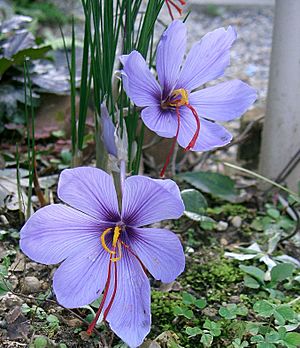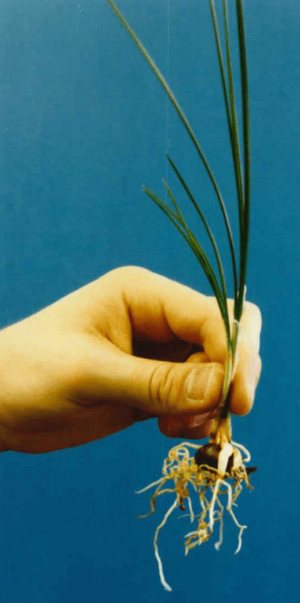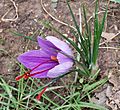Saffron crocus facts for kids
The Crocus sativus, often called the saffron crocus or autumn crocus, is a type of flowering plant. It belongs to the Crocus group within the iris family, Iridaceae. This plant is famous for giving us the valuable spice called saffron. Saffron comes from the tiny red threads, called stigmas, found inside its beautiful purple flowers.
It's important not to confuse the saffron crocus with another plant also called "autumn crocus" (from the Colchicum group). While they look similar, the Colchicum plant is poisonous. You can tell them apart because true crocuses have three stamens (pollen parts) and three styles (parts that lead to the seed), while Colchicum plants have six stamens and only one style.
This plant grows from a special underground stem called a corm, which is like a bulb. It blooms in the autumn. The saffron crocus does not grow naturally in the wild anymore. People have been growing it and using saffron for over 3,500 years! It has been important to many different cultures and civilizations around the world. Today, Crocus sativus is grown in areas like the Mediterranean, East Asia, and the Irano-Turanian Region. Scientists believe saffron crocus first appeared in Southern Greece, possibly on the Attic peninsula or the island of Crete. It likely came from a wild plant called Crocus cartwrightianus.
Quick facts for kids Saffron crocus |
|
|---|---|
 |
|
| Flowers showing crimson stigmas | |
| Scientific classification | |
| Genus: |
Crocus
|
| Species: |
sativus
|
Contents
What the Saffron Crocus Looks Like
The saffron crocus grows from a corm, which is like a small, round underground stem. This corm protects the plant's leaves and flower stalk while they are underground. In the autumn, the plant usually blooms with lovely purple flowers. It can grow to be about 10 to 30 centimeters (4 to 12 inches) tall.
The saffron crocus has 24 chromosomes. This is three times the usual number for its type of plant. This special genetic makeup means the plant cannot make seeds on its own. It is sterile, so it needs human help to reproduce.
How Saffron Crocus is Grown
Since the saffron crocus doesn't grow in the wild and can't make seeds, people have to plant its corms to grow new plants. The Crocus cartwrightianus is thought to be its wild ancestor.
To grow saffron crocuses, you should plant the corms about 10 centimeters (4 inches) apart and 10 centimeters (4 inches) deep in the soil. These flowers grow best in sunny spots with soil that drains water well and has some good organic material. The corms will multiply each year, and the plants can last for 3 to 5 years.
How Saffron is Used
Saffron is known as one of the most valuable spices in the world. It takes a lot of work to get it! To produce about 1 pound (0.45 kg) of saffron, you need between 50,000 and 75,000 saffron crocus plants. This is because each flower only produces three tiny red threads, which are the stigmas.
The best time to harvest these stigmas is in the middle of the morning when the flowers are fully open. Remember, the saffron crocus (Crocus sativus) is different from the "meadow" saffron or autumn crocus (Colchicum autumnale), which is poisonous.
Saffron Crocus Reproduction and Breeding
Because the saffron crocus cannot make seeds on its own, all the plants grown today are basically copies of each other. This means there isn't much genetic variety among them. It's quite hard to find new types of saffron crocuses with different or better features.
However, people still try to create new types of saffron plants using a few methods:
- Clonal Selection: If a plant shows a new, good change (a mutation), people can grow more copies of that specific plant. This is the traditional way.
- Mutation Breeding: Scientists can use special methods to cause changes (mutations) in the plants. Then, they look for plants with useful new features.
- Sexual Reproduction: Even though the saffron crocus can't self-pollinate, its pollen can sometimes be used to pollinate some of its wild relatives in a lab. This can create seeds, which might lead to new, fertile plants that have some of the saffron crocus's good qualities. Scientists are also exploring ways to make the saffron crocus itself fertile, perhaps by doubling its chromosomes.
Gallery
-
Flower's profile, Serra de Casteltallat, Catalonia, Spain
-
Pollen, Afghanistan
See also
 In Spanish: Flor del azafrán para niños
In Spanish: Flor del azafrán para niños







